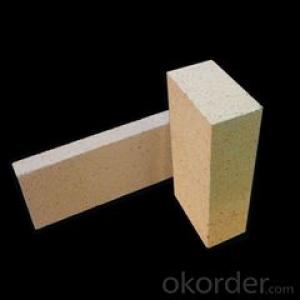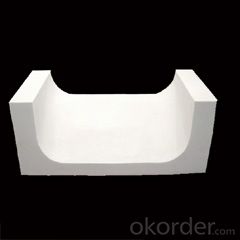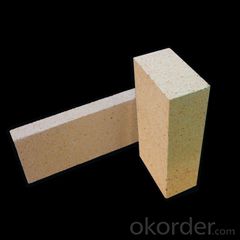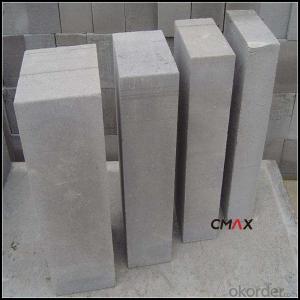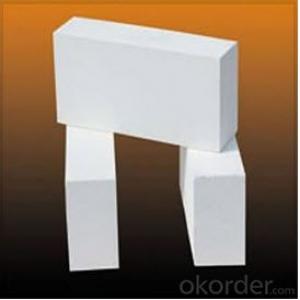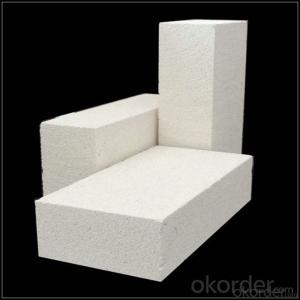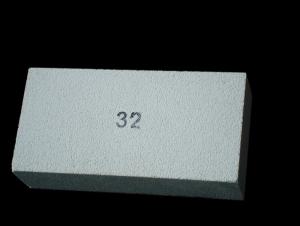Refractory Insulation Fire Brick, Insulating Fire Brick
- Loading Port:
- Shanghai
- Payment Terms:
- TT OR LC
- Min Order Qty:
- 10 m.t.
- Supply Capability:
- 100 m.t./month
OKorder Service Pledge
OKorder Financial Service
You Might Also Like
Quick Details
| Place of Origin: | Shape: | Brick | Material: | Alumina Block |
| SiO2 Content (%): | Al2O3 Content (%): | as usual | MgO Content (%): | general |
| CaO Content (%): | Refractoriness (Degree): | Common (1580°< Refractoriness< 1770°) | CrO Content (%): | 0 |
| SiC Content (%): | Model Number: | DLG, PLG | Brand Name: | |
| name: |
Packaging & Delivery
| Packaging Detail: | 1.The Insulating Fire Brick will be packed as the standard of exporting or packed on wooden pallet with three layers water-proof shrink film and tightened with plastic/steel bandages,when in the transportation process,we should pay attention to moisture-proof and light handling. 2.The packing of Refractory Brick will accept customer's requirement if any. 3.Delivery within 7-15 working days after your payment. 4.Fast delievery accepted by customers. |
| Delivery Detail: | within 20 days |
Refractory Bricks for Furnace
Product Description
We are a professional company which has manufactured bricks for more than25 years, we can supply Fire Caly brick, High alumina bick, Tunnel kiln car brick, Silica brick, Big block for glass furance and Coke Dry Quenching, calcined alumina powder and Kaolin. Our company is the direct maker and supplier inChina.
Fire brick, refractory brick, insulation brick, insulating fire brick, insulation refractory brick, fire bricks, refractory bricks, insulation bricks, insulating bricks, insulating fire bricks, insulator, fire proof brick, lining brick, hot face bricks, cold face bricks,
Two type of our Alumina Insulating Fire Brick (LG-IFB):
Ordinary type (PLG-IFB)
Low iron type (DLG-IFB)
Two produce methods of our LG-IFB:
Fast foam setting technology
Method of burning up adding object
Characteristics of our LG-IFB:
High cold crushing strength
High softing temperature under load
Accurate dimension
Good thermal shock resistance
Application:
Widely used in insulating layers of various thermal equipments and linings where no high temperature melt corrosion occurs.
| Item | PLG- 1.0 | PLG- 0.9 | PLG-0.8 | PLG-0.7 | PLG-0.6 | PLG-0.5 | |||
| Al2O3 ,% ≥ | 48 | ||||||||
| Fe2O3 ,%≤ | 2 | ||||||||
| BD(g/cm3) | 1.0 | 0.9 | 0.8 | 0.7 | 0.6 | 0.5 | |||
| CCS>(Mpa) | 4.50 | 4.00 | 2.94 | 2.45 | 1.96 | 1.47 | |||
| TC<(350±25ºC) | 0.55 | 0.50 | 0.35 | 0.30 | 0.25 | 0.20 | |||
| test temperature at PLC<2% ºC | 1400 | 1400 | 1400 | 1350 | 1350 | 1250 | |||
| tolerance of dimension(mm) | PLG-IFB | DLG-IFB |
| ≤100 | ±1.5 | ±1.0 |
| 101-250 | ±2 | ±1.0 |
| 251-400 | ±3 | ±1.5 |
| warpage(mm) | ||
| ≤250 | ≤1 | ≤0.8 |
| 251-400 | ≤1.5 | ≤1.0 |
| crack(mm) | ||
| ≤0.25 | unlimited | unlimited |
| 0.26-1.0 | 30 | 30 |
| >1.0 | rejected | rejected |
1.Raw materials blending
Independent raw materials blending center to assurestrict control of materials quality.
2.Shaping
Isostatic pressing technoloty,with as 1000 tons of pressure to assure the homogenous bulk density of each product.
3.Machining
To assure the uniform shape,dimension and dimension tolerance of each product.
4.X-ray defect inspection
To assure all products supplied to our customers without any defect and to prevent the un-countable feconomic loss for our customers.
5.Physical and chemistry analysis
To assure all products meet the physical and chemistry characteristics.
6.Packaging
The world-class for packaging to assure the safety transportation.
- Q: Can insulating fire bricks be used in chimneys or flue systems?
- Yes, insulating fire bricks can be used in chimneys or flue systems. Insulating fire bricks are specifically designed to withstand high temperatures and provide excellent insulation. They are commonly used in applications where heat needs to be retained or reflected, such as in chimneys or flue systems. These bricks are capable of withstanding temperatures up to 3000°F (1650°C), making them ideal for use in environments with extreme heat. Additionally, their insulating properties help to minimize heat loss, improve energy efficiency, and prevent damage to surrounding structures. However, it is important to note that insulating fire bricks should be installed according to the manufacturer's guidelines and local building codes to ensure safe and proper usage.
- Q: Can insulating fire bricks be used in the insulation of walls and roofs?
- Insulating fire bricks are primarily designed for use in high-temperature applications such as kilns, furnaces, and fireplaces. While they are excellent at withstanding extreme heat, they may not be the best choice for insulation in walls and roofs. Insulating fire bricks have a high thermal resistance, which means they can effectively reduce heat transfer. However, they are not as effective in preventing air infiltration or providing a high level of insulation compared to other materials specifically designed for building insulation. For insulation purposes in walls and roofs, it is more common to use materials such as fiberglass, mineral wool, foam boards, or spray foam insulation. These materials have better insulating properties and are specifically engineered to provide thermal resistance, air sealing, and moisture control. If you are considering using insulating fire bricks for wall or roof insulation, it is important to consult with a professional who can assess your specific needs and recommend the most suitable materials for your project.
- Q: Do insulating fire bricks require a protective coating?
- A protective coating is not always essential for insulating fire bricks, given their inherent ability to endure high temperatures and provide insulation. These bricks are composed of lightweight refractory materials with exceptional thermal conductivity characteristics, enabling them to retain heat and inhibit heat transfer. However, in certain instances where the bricks may be exposed to corrosive substances or aggressive chemicals, it may be advisable to apply a protective coating to enhance their longevity and resilience. Ultimately, the necessity of a protective coating hinges on the particular application and surrounding environment in which the insulating fire bricks are employed.
- Q: How do insulating fire bricks affect the overall fire resistance of a structure?
- Insulating fire bricks play a crucial role in enhancing the overall fire resistance of a structure. These specialized bricks are designed to withstand high temperatures and act as an effective thermal barrier. By insulating the structure, they help to reduce heat transfer and prevent the spread of fire. Insulating fire bricks possess a low thermal conductivity, which means they do not easily conduct heat. This property enables them to absorb and store heat energy, preventing it from being transmitted to other parts of the structure. As a result, the fire is contained within a specific area, minimizing the risk of spreading to adjacent areas. Furthermore, insulating fire bricks have a high melting point, making them extremely resilient to heat. This allows them to effectively withstand prolonged exposure to intense temperatures without deforming or disintegrating. By preserving their structural integrity, these bricks ensure the stability and integrity of the overall structure during a fire event. In addition to their insulation and heat resistance properties, insulating fire bricks also act as a barrier to flames and combustion gases. Their dense composition obstructs the passage of flames and smoke, preventing them from permeating through the structure. This containment helps to limit the damage caused by fire and provides valuable time for occupants to evacuate safely. Overall, the incorporation of insulating fire bricks in the construction of a structure significantly enhances its fire resistance. They provide insulation, prevent the spread of fire, maintain structural stability, and act as a barrier against flames and smoke. By reducing heat transfer and containing the fire, insulating fire bricks play a vital role in safeguarding the structure and its occupants during a fire emergency.
- Q: Are insulating fire bricks fireproof?
- Yes, insulating fire bricks are fireproof. They are designed to withstand high temperatures and provide insulation to prevent heat transfer. Insulating fire bricks are made from refractory materials that have a high melting point and can withstand extreme heat without melting or crumbling. They are commonly used in applications where high temperatures are present, such as kilns, furnaces, fireplaces, and ovens. Insulating fire bricks are an excellent choice for fireproofing as they offer excellent thermal insulation properties and can effectively protect against the spread of fire.
- Q: Are insulating fire bricks suitable for insulation in petrochemical plants?
- Insulating fire bricks, which are composed of lightweight materials with exceptional insulating properties like ceramic fibers or lightweight refractory aggregates, are well-suited for insulation in petrochemical plants. These bricks possess a low thermal conductivity that effectively curbs heat transfer and provides insulation in high-temperature settings. In petrochemical plants, where the manipulation of flammable and hazardous substances occurs, maintaining proper insulation is of utmost importance for safety and efficiency. By withstanding extreme temperatures and delivering superb thermal insulation, insulating fire bricks effectively curtail heat loss and diminish energy consumption. Moreover, insulating fire bricks exhibit resistance to chemical corrosion, rendering them suitable for deployment in petrochemical plants frequently exposed to corrosive chemicals. Additionally, these bricks demonstrate durability and commendable mechanical strength, enabling them to endure the harsh conditions typically encountered in petrochemical plants. All in all, insulating fire bricks emerge as the ideal choice for insulation in petrochemical plants due to their capacity to withstand high temperatures, exceptional thermal insulation properties, resistance to chemical corrosion, and remarkable durability.
- Q: Are insulating fire bricks resistant to salt attack?
- Insulating fire bricks do not typically possess resistance against salt attack, which refers to the deterioration and corrosion of materials caused by salt or saltwater exposure. Although insulating fire bricks are engineered to have exceptional thermal insulation properties, they are not specifically formulated to endure the damaging effects of salt. Salt attack has the potential to weaken the structure of the bricks, leading to a decrease in their performance and durability over time. If these bricks are consistently exposed to salt or saltwater, it is probable that their degradation will be hastened, making them unreliable for long-term use in such environments. To ensure resilience against salt attack, it is advised to utilize refractory materials specially designed for this purpose, such as salt-resistant fire bricks or refractories with a higher alumina content. These materials have been developed to withstand the corrosive impacts of salt and are better suited for applications where exposure to salt or saltwater is anticipated.
- Q: Can insulating fire bricks be used for insulation in autoclaves?
- Yes, insulating fire bricks can be used for insulation in autoclaves. Insulating fire bricks are designed to have low thermal conductivity, which means they can effectively retain heat and withstand high temperatures. Autoclaves require insulation to maintain a consistent temperature and pressure, and insulating fire bricks can provide excellent insulation properties in these demanding conditions. Additionally, their high strength and durability make them suitable for withstanding the intense heat and pressure cycles that occur in autoclaves. Overall, insulating fire bricks are a reliable and effective choice for insulating autoclaves.
- Q: Can insulating fire bricks be used for insulation in boilers?
- Yes, insulating fire bricks can be used for insulation in boilers. Insulating fire bricks are specifically designed to withstand high temperatures and provide excellent thermal insulation. They have low thermal conductivity, meaning they can effectively reduce heat loss and improve the energy efficiency of boilers. Additionally, insulating fire bricks are lightweight and easy to install, making them a popular choice for insulation in boilers. They can help maintain high temperatures inside the boiler, allowing for efficient combustion and heat transfer, while also protecting the outer structure from excessive heat. Overall, insulating fire bricks are a reliable and effective choice for insulation in boilers.
- Q: Are insulating fire bricks environmentally friendly?
- To a certain degree, insulating fire bricks can be deemed environmentally friendly. These bricks are crafted from abundant and readily accessible natural materials like clay, shale, and other minerals. Consequently, they do not contribute to the depletion of our natural resources. Furthermore, insulating fire bricks are engineered to possess low thermal conductivity, which aids in diminishing energy consumption. By utilizing these bricks, buildings can achieve better insulation, resulting in reduced heating and cooling requirements and, subsequently, decreased greenhouse gas emissions. Nevertheless, the manufacturing process of insulating fire bricks does have some environmental repercussions. The firing process necessitates high temperatures, which can lead to air pollution and greenhouse gas emissions. Additionally, extracting the raw materials for these bricks may cause some environmental disturbances. To truly assess the environmental friendliness of insulating fire bricks, it is vital to take into account the entire life cycle, encompassing raw material extraction, manufacturing, transportation, and disposal. Furthermore, comparing them to alternative insulation materials can offer a more comprehensive perspective on their environmental impact. In conclusion, while insulating fire bricks possess certain eco-friendly qualities such as being made from natural materials and reducing energy consumption, their overall environmental impact should be assessed holistically.
Send your message to us
Refractory Insulation Fire Brick, Insulating Fire Brick
- Loading Port:
- Shanghai
- Payment Terms:
- TT OR LC
- Min Order Qty:
- 10 m.t.
- Supply Capability:
- 100 m.t./month
OKorder Service Pledge
OKorder Financial Service
Similar products
Hot products
Hot Searches
Related keywords

